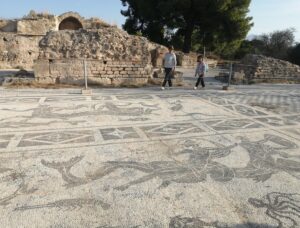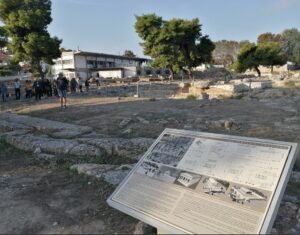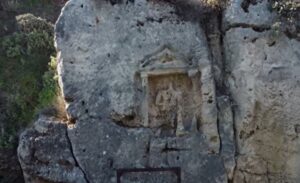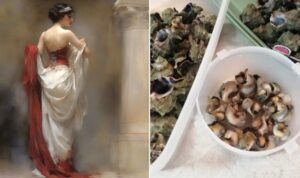Today, I am pleased to share my photographs from the Isthmia Museum and Archeological site. The latter boasts the Roman Baths with the largest monochrome fresco in the eastern Mediterranean! And it is STUNNING, adorned with a variety of sea creatures (octopus, fish, lobster, squid, dolphin, sea snake) and mythological marine creatures too, including what looks like a Nereid and a Triton.
We happened to visit on the day that the ancient games of Isthmia were revived in the area for the first time, and we spotted in the museum two locals preparing the pine tree wreaths for the winners.
We left the place before the games began, so we didn’t see any sporting action. But after seeing that breathtaking fresco, and with the cruise of the Corinth Canal as our next stop that day, we didn’t feel like hanging around LOL!
The museum was tiny but very interesting, with a plethora of artifacts in great condition that helped to imagine the everyday life of my ancient ancestors.
The archaeological grounds were mere ruins, nothing standing except for the Roman baths. We had to imagine the Temple of Poseidon, the stadium, and the other buildings we got to see only on signs, but the pine trees were ample – holy trees to Poseidon, apparently!
When I heard that from our guide, I wondered if this is why there are so many pine trees on Greek beaches. Or, maybe, it’s the other way around. The Greeks imagined Poseidon liked them seeing that they are often found so close to seawater. I guess we’ll never know, LOL!
The archaeological site is set on a hill that overlooks the bay. It is a short drive away from Isthmia where the Corinth Canal begins.
In my recent newsletter and blog post about my cruise through the Corinth Canal, I mentioned that the ancient Greeks had conceived the idea of the canal so the ships did not have to circumnavigate the Peloponnese to go to the other side of mainland Greece. However, their plans never turned into action as when they asked Zeus for permission to go ahead (via the high priestess and Oracle Pythia of Delphi), his reply was negative.
Still, that didn’t stop the Corinth tyrant Periander in the 7th century BC. He did try to dig for a canal but found the task far more demanding and expensive than he’d thought. So, he constructed a ‘diolkos’ instead, i.e. a passageway from one shore to the other that involved dragging the boats across the land on porous blocks.
Later, the Romans tried too. During the reign of Tiberius, another failed attempt was made in 32 AD but their equipment and know-how proved inadequate for this feat. They, too, settled for another solution, similar to the Greek ‘diolkos. The Romans went for an Egyptian mechanism that had been used previously to roll huge blocks of granite to build their pyramids. The boats rolled across the Isthmus upon tree trunks.
In 67 AD, philhellene Roman Emperor Nero ordered six thousand slaves to dig a canal with shovels. Most of them were Jewish pirates during the Jewish wars. Nero was so keen on the project he was the one to give the first blow to the land of the Isthmus with a golden pickaxe.
Sadly, he passed away the next year and the project was soon abandoned.
Today, a relief adorns the wall of the canal near Isthmia. It is on the side of the mainland, not the Peloponnese, i.e. on the right side as you begin the boat cruise from the Saronic Gulf (Isthmia) side. You will see it high up on the canal wall right next to an old stone base to a bridge over the canal that no longer exists.
It is a mystery as to who created this relief of Nero and when, but it is said to be a remnant from a temple built there in his honor.
It is sad it has been left to its fate as it continues to fight a losing battle with the elements, but here it is, a quickly fading image of the man who had the dream of the canal and went the furthest along than any other.
He was the most determined to do it, and he followed through, in a world that didn’t yet have the mechanical and technological marvels of today.
To hear more about the Corinth Canal, for fun facts, and to see photos, see this blog post.
All this talking about emperors made me think of the purpura mollusk and I have to tell you why!
This mollusk is an exquisite meze for Greeks in the know. It also carries an ancient secret related to royalty!
Porpura derives its name from ‘porphura’, the dated Greek word for ‘purple’ (pronounced ‘porfeera’). This is the Greek name for this mollusk. In ancient times, they were used to extract the color purple, which was then used to dye the clothes of kings and emperors. The practice is 3,000 years old.
GO HERE TO READ THE REST OF THE POST
Sharing is caring! Here’s a ready tweet for you to spread some love:
Interested in travel, food and books from Greece? Here's a blog you will love! #Greek #blogger #writer Share on X
3 FREE books for you! Sign up below to receive them instantly!
NEW! Clean Christmas romance. Single mother Cathy Roussos gave up on love long ago, and veterinarian Alex Rallis doesn’t believe in it, but one magical Christmas on a Santorini farm might just change everything…
Check it out on Amazon Read a FREE sample!
A clean romantic suspense short read with an unreliable narrator that’ll keep you guessing! Vera is losing her mind over famous actor Yannnis Ksenos, except, she isn’t just a fan… Now, she plucks up the courage to ring his doorbell… Visit Amazon











